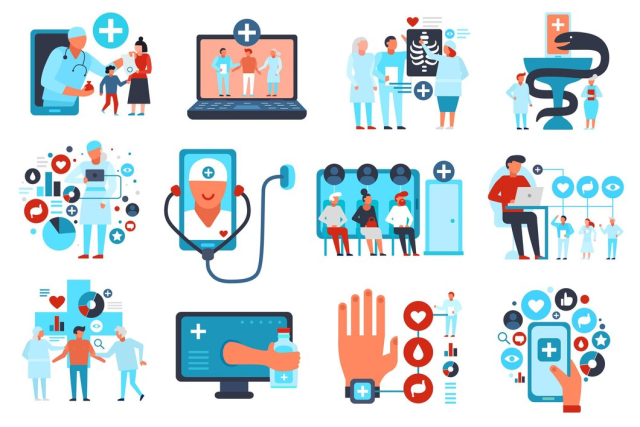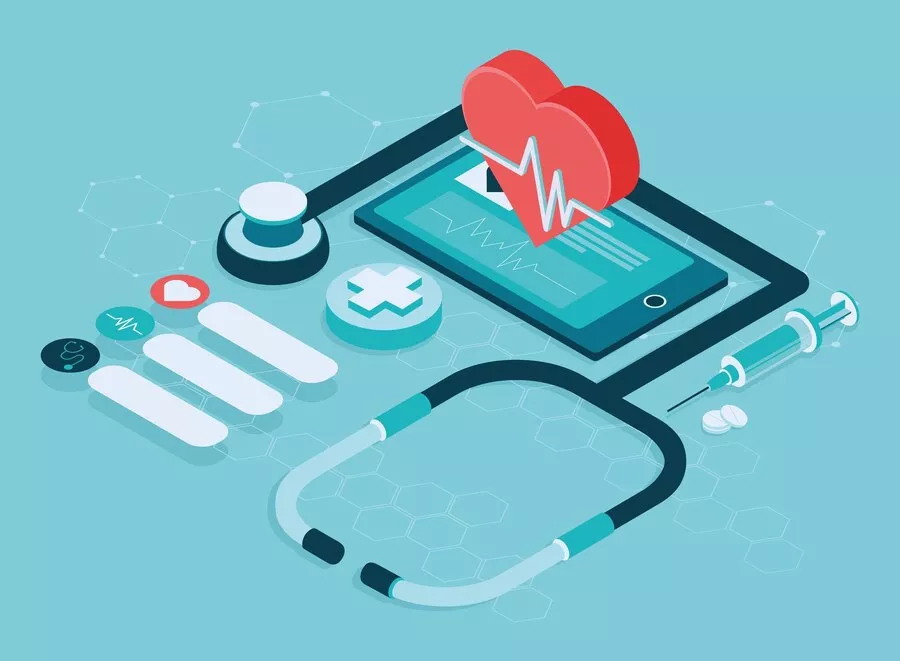
The healthcare industry is digital and rapidly embracing transformation. Institutions are adopting the latest technologies to improve patient care, enhance operational efficiency, and reduce costs. This article explores the top 5 most popular types of digital health solutions being implemented at pace in hospitals and clinics, using internet-connected devices to collect real-time patient health data, such as blood pressure, oxygen levels, weight, etc., and other medical facilities.
1. Telehealth Solutions
Telehealth solutions enable patients to access medical care remotely via phone, mobile app, online video chat and other telecommunication technologies. These solutions saw tremendous growth during the COVID-19 pandemic as patients switched to remote medical visits.
Popular telehealth solutions include:
- Telemedicine apps and software: Allow patients to connect with doctors through live video visits, share medical data, receive diagnoses and get e-prescriptions. Providers like Teladoc, Doxy.me and Amwell lead this space.
- Remote patient monitoring (RPM): Uses internet-connected devices to collect real-time patient health data like blood pressure, oxygen levels, weight etc. and share it with providers. Players like Langate offer remote patient monitoring software development solutions.
- mHealth apps: Enables patients to use smartphone apps to track health indicators, access health resources and share data with their providers. Examples include fitness apps, chronic disease management apps, medication reminder apps and more.
Telehealth improves access to care, allows remote treatment of minor conditions, and facilitates better management chronic of diseases. These solutions are seeing high clinical adoption and utilization by patients as well.
2. Electronic Records Health (EHRs)
Electronic Health Records (EHRs) are one of the most widely adopted digital health solutions. EHRs are digital versions of patient medical information, including health history, diagnoses, medications, treatment plans, immunization dates, allergies, radiology images, and lab test results.
Key benefits of EHRs:
- Improved workflow efficiency - EHRs eliminate paperwork, provide real-time access to patient data and enable faster decision-making.
- Enhanced patient care coordination - Multiple care providers can access the patient's same information across different healthcare settings.
- Reduced medical errors - EHRs incorporate clinical decision support and e-prescribing with safety checks.
- Cost savings - EHRs eliminate duplication in documentation, which leads to cost efficiencies.
According to Becker's Hospital Review, over 96% of hospitals in the US use a certified EHR system today. Smaller physician practices are also rapidly adopting EHR solutions to qualify for government incentives and avoid penalties.
3. Healthcare IoT
The Internet of Medical Things (IoMT) includes a range of connected healthcare devices - from wearables and ingestibles to hospital assets. IoT software development for pharma is helping clinicians monitor patient health more closely for better outcomes.
Major IoMT solution types include:
- Connected imaging equipment (CT, MRI, ultrasounds etc.) that uses embedded sensors, WiFi and Bluetooth to analyze machine performance and schedule predictive maintenance.
- RFID and RTLS (real time location systems) to track medical assets like wheelchairs, defibrillators and other mobile hospital equipment to optimize utilization and prevent losses.
- Telemetry devices, such as ECG monitors, smart beds, and ventilators, continuously track patient vitals and send alerts during adverse events.
- Implantable devices like pacemakers, insulin pumps and cardiac monitors capture health metrics and transmit data wirelessly to care providers.
By generating real-time health insights, the MT IoT empowers clinicians to make data-driven care decisions and enables remote patient monitoring.
4. Healthcare Analytics
Healthcare analytics leverages advanced technologies like predictive modeling, data mining, AI and machine learning to derive insights from patient data stored across disparate systems.
These analytical capabilities help health systems with:
- Clinical analytics: Identify high-risk patients, reduce readmissions, improve medication adherence, inform new treatment pathways and enhance quality of care.
- Operational analytics: Optimize staff schedules, improve asset utilization, minimize wait times, enhance workflow efficiency and monitor supply chains.
- Financial analytics: Detect insurance fraud, reduce claims processing time, identify revenue leakage areas and enable performance benchmarking.
By uncovering data-driven insights, healthcare analytics solutions are instrumental in driving process improvements and delivering better patient outcomes in a cost-efficient manner. In the insurance sector, insurance claims management software leverages these insights to automate claim approvals, detect fraud, and enhance processing efficiency.
Major vendors offering analytics solutions include Epic, Cerner, Optum, IBM Watson Health and Health Catalyst.
5. Healthcare Interoperability Platforms

Lack of systems interoperability has been a major roadblock preventing seamless data sharing across disparate healthcare IT systems. Interoperability platforms are addressing this challenge.
These platforms provide interconnectivity services that enable smooth data flow between electronic health record systems (EHRs), medical devices, healthcare apps and other systems.
Some offerings in space include:
- Integration engines: Real-time, bidirectional data sharing between healthcare applications via APIs.
- Health Information Exchanges (HIE): Enables patient health records to be shared securely across unaffiliated providers on a common network.
- Patient portals: Gives access to patients to their medical information across multiple providers through a single portal view.
Interoperability platforms are helping clinicians access comprehensive patient information at the point of care by bridging disconnected systems. This leads to fully informed diagnoses and treatment decisions.
In summary, the digital transformation sweeping the healthcare ecosystem is being fueled by the innovative health IT solutions outlined above. These technologies are helping providers enhance both patient outcomes and profit.
Disclaimer: This post was provided by a guest contributor. Coherent Market Insights does not endorse any products or services mentioned unless explicitly stated.





